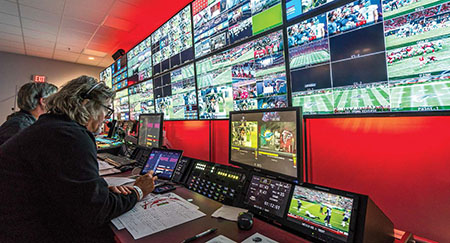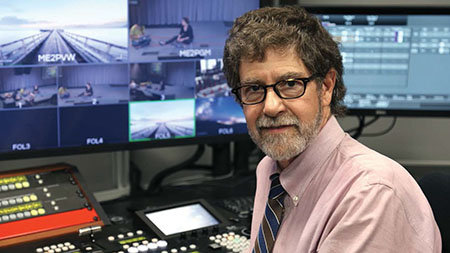Ready to Go IP?
OTTAWA—IP-based production facilities are all broadcasters are asking for these days, say the integrators who design and build these facilities for them.

Diversified recently built the video production system at the new Mercedes Benz Stadium in Atlanta. The technical architecture is built upon the new SMPTE Standards for live, real-time, high bit rate, IP technologies. While technically this is a hybrid system; i.e., IP/SDI—the entire core is all IP; there is no SDI routing in this facility.
“Are we getting a lot of demand for IP-based facilities rather than SDI-based? Absolutely yes,” said Dave Van Hoy, president of Advanced Systems Group (ASG) in Emeryville, Calif.
“In fact, I would say that 100 percent of what broadcasters are asking for is IP-based, whether it be for the entire system, core routing or remote islands” added Jim Conley, senior vice president of engineering/CTO at Communications Engineering Inc. (CEI) in Newington, Va. “They want to go IP-based to some extent even if they are renovating an existing facility, rather than building something new.”
But just because broadcasters are willing to pay to go all-IP now doesn’t make doing so a good idea, said Van Hoy. In fact, for single stations and smaller broadcast groups, “there is no immediate benefit to moving to IP right now,” he said.
IP IS HERE NOW—PARTIALLY
Despite the fact that most TV broadcasters currently work in an SDI environment, IP has already made inroads into their facilities.
It’s not just the Ethernet-connected desktop computers that are IP-based. Multiviewers and other IP-based devices that interconnect easily to SDI production infrastructures using gateway devices (aka IP/SDI converters), are in widespread use, according to TV Technology Columnist Karl Paulsen, CTO at Diversified in Kenilworth, N.J.
Get the TV Tech Newsletter
The professional video industry's #1 source for news, trends and product and tech information. Sign up below.
“This is why most current ‘IP broadcast facilities’ today are actually hybrids,” Paulsen said. “That is, they use both IP-based and SDI-based equipment.”
Saving money is the main reason broadcasters are asking system integrators such as ASG, CEI, and Diversified to build all-IP plants. “They’ve heard that all-IP plants are cheaper to build, because they can use low-cost commercial off-the-shelf [COTS] servers, storage devices, and input/output switches to run their production facilities, rather than expensive, dedicated use proprietary SDI equipment,” said Van Hoy. “Broadcasters don’t really care about the technological advances IP can deliver over SDI.”
Van Hoy added that the broadcasters’ perception about IP being cheaper than SDI is theoretically correct. In an all-IP production environment, COTS IP-based equipment does cost far less than its SDI equivalent; while performing the same functions equally well, or better. “You can even build a ‘virtual machine’ from IP-based COTS servers to handle playout and transcoding, rather than using dedicated SDI-based hardware,” said Conley. “When you are done with it, the IP-based servers used to create the virtual machine can be repurposed on demand as workflow and workloads require them.”
An IP-based production facility offers other benefits over SDI. “Using networked servers over IP, you can spin up new broadcast program streams relatively cheaply and quickly, compared to building a new SDI plant,” Paulsen said. “You can spin them down just as easily, without the loss in investment associated with a hardware-based SDI-based facility.”
That’s not all: IP-based production facilities can be physically distributed over many locations, yet be integrated over IP to act as one. (This can’t easily be done with SDI.) Meanwhile, the IP infrastructure can be future-proofed by using fiber-optic cabling and high data rate switches (100 Gbps), to handle the streams and flows associated with 4K, 8K and beyond.

Dave Van Hoy, president of Advanced Systems Group
THE DOWNSIDES
With all these advantages, it is easy to see why broadcasters are asking for end-to-end IP-based broadcast facilities. And yet going all-IP now isn’t a good idea for everyone, said Dave Van Hoy. “In fact, if you operate a station that uses 16 or fewer cameras, moving to IP isn’t worth it today.”
Although some native IP TV equipment is now available, “the vast majority of signal processing equipment used in broadcast production is still SDI-based,” said Van Hoy. “This means you have to convert everything to and from IP using gateways, which is a tremendous cost addition to any facility, and offers its own level of complexity.” In addition, interoperability among vendors’ IP-based broadcast equipment is “extremely poor,” according to Van Hoy. “It is difficult to connect Grass Valley’s TICO-based IP equipment to an Evertz-based Aspen system, and have the two work well together,” he said. “At best, you have to choose one vendor’s ecosystem and stay within it, which defeats the open standard/COTS logic of going all-IP.”
Moving to IP can be a major capital investment. As a result, “stations with small capital budgets can’t afford to go all-IP at once,” said Paulsen. “At best, they are more likely to do it piece by piece.”
In general, system integrators view IP as a technological advance worth embracing, similar to the transition from analog to digital and HDTV. “Make no mistake: IP is the future,” said Conley. That said, the fact that IP-based production facilities are the future does not mean that every broadcaster should reject the hybrid model, and abandon SDI right now.
“You need to take a balanced and informed approach to deciding whether going all-IP now is best for your operation, or whether you should wait,” said Paulsen.
Van Hoy agrees: “When you do make this choice, you’ve got to do so rationally,” he said. “Don’t get swept away by the all-IP dogma, and end up with an expensive broadcast facility that is much more than you currently need.”
James Careless is an award-winning journalist who has written for TV Technology since the 1990s. He has covered HDTV from the days of the six competing HDTV formats that led to the 1993 Grand Alliance, and onwards through ATSC 3.0 and OTT. He also writes for Radio World, along with other publications in aerospace, defense, public safety, streaming media, plus the amusement park industry for something different.

